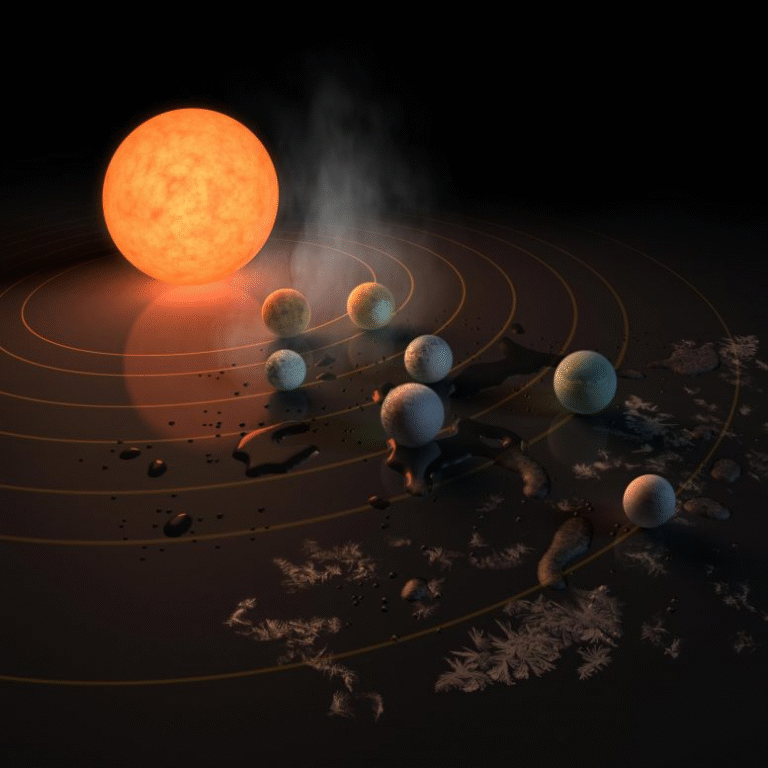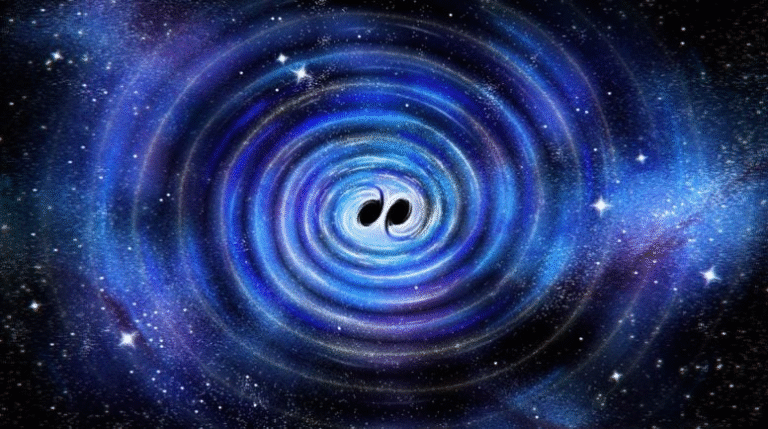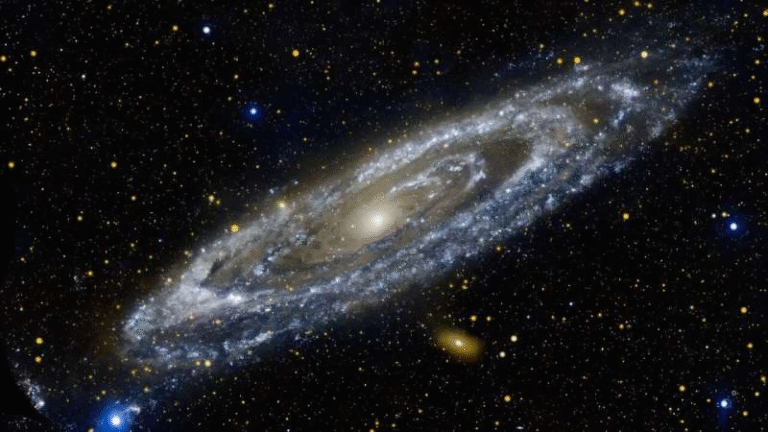Magnetic Fields Found Steering Star Formation in the Perseus Cloud

Astronomers have made a groundbreaking discovery that reshapes how we understand the birth of stars. Using the Atacama Large Millimeter/submillimeter Array (ALMA) in Chile, a team led by Paulo Cortés from the U.S. National Science Foundation’s National Radio Astronomy Observatory (NRAO) and the Joint ALMA Observatory has detected, for the first time, a magnetically guided streamer feeding material into a young binary star system.
This discovery, centered on a system known as SVS 13A in the Perseus molecular cloud, provides clear evidence that magnetic fields play an active role in channeling star-building material, not just a passive one as once thought.
The Discovery
The research, published in The Astrophysical Journal Letters (2025), used ALMA’s unparalleled sensitivity to observe a narrow, spiral-shaped streamer of gas directly linking a surrounding cloud to the disk of the newborn stars. This structure acts as a cosmic delivery channel, guiding matter along a curved path sculpted by invisible magnetic forces.
In essence, this streamer—called a sub-Alfvénic streamer—is moving slower than the Alfvén speed (the speed at which magnetic waves move through plasma). That means magnetic forces dominate over turbulence or gravity in this region, smoothly funneling gas toward the forming stars.
The ALMA images revealed two dusty spiral arms wrapping around the binary system, along with a streamer that closely traces the same spiral route. This alignment is no coincidence—it’s evidence that the magnetic field and the flow of gas are working in tandem, shaping the growth of the system in a highly coordinated way.
Why This Is So Important
Traditionally, scientists believed that gravity alone drives the collapse of interstellar gas clouds to form stars. However, this new finding shows that magnetic fields do much more than resist or slow collapse—they can actually guide it. The result changes how we think about the early stages of star and planet formation.
This isn’t just an academic curiosity. The way gas flows into a newborn system directly affects how disks form, how stars gain mass, and how planets might eventually emerge. A magnetically regulated inflow suggests that star formation could be more organized and less chaotic than previously assumed.
In short, magnetism is not just a background player—it’s a structural architect in stellar nurseries.
The Target: SVS 13A in the Perseus Molecular Cloud
The team focused on SVS 13A, a young binary protostellar system located roughly 300 parsecs (about 980 light-years) away in the Perseus region. SVS 13A consists of two main components—known as VLA 4A and VLA 4B—surrounded by a shared disk of gas and dust.
ALMA’s observations were conducted as part of the ALMA Perseus Polarization Survey (ALPPS), which maps dust polarization and molecular gas emission to trace both magnetic fields and kinematics in star-forming regions.
The observations captured:
- 870 micron dust continuum emission (revealing the spiral arms).
- C¹⁷O (3→2), C¹⁸O (2→1), and DCN (3→2) molecular line data (tracing the motion and density of the gas).
- Polarization maps that trace the orientation of magnetic field lines in the region.
The Numbers That Matter
The team measured a plane-of-sky magnetic field strength of about 1.1 ± 0.6 milliGauss, a significant value on astronomical scales. By comparing magnetic and kinetic energies, they found that the magnetic energy is roughly twice as large as the turbulent kinetic energy, indicating that magnetic fields strongly control the gas motion.
They also determined that the Alfvénic Mach number (Mₐ)—the ratio of gas flow speed to Alfvén speed—is less than one in the streamer. This confirms the sub-Alfvénic nature of the flow, meaning that magnetic pressure dominates over turbulent motion.
In simple terms: the gas isn’t just falling freely—it’s being guided, almost “magnetically shepherded,” into the star system.
A Controlled Cosmic Highway
Imagine a cosmic garden hose—but instead of water, it’s channeling interstellar gas through a spiral path shaped by magnetic fields. That’s what ALMA captured. This streamer doesn’t just connect the cloud to the disk; it feeds material in a stable, orderly way. The researchers describe it as a “dedicated highway” for star-building gas.
This finding also fits with earlier observations. In 2022, NOEMA (another radio observatory) had spotted a similar streamer feeding SVS 13A but couldn’t determine the magnetic influence. ALMA’s new polarization and high-resolution data now confirm that magnetic fields are not only present but dominant.
Magnetic Fields: The Hidden Architects of the Universe
So, how do magnetic fields play this role?
In star-forming clouds, magnetic fields thread through vast amounts of gas and dust. These fields resist compression and guide the motion of charged particles. When strong enough, they can channel infalling material along specific paths, rather than letting it collapse randomly under gravity.
In this case, the fields around SVS 13A are well aligned with both the dust spirals and gas velocity gradients. That alignment proves that magnetic fields are steering gas inflow, creating an elegant feedback between magnetism, gravity, and angular momentum.
Magnetic guidance like this could explain why some protoplanetary disks show beautiful spiral arms, how binary systems form with balanced mass ratios, and even how planets inherit angular momentum.
A Step Forward for Star Formation Studies
This observation is the first time that both a magnetically guided streamer and its field structure have been directly mapped in a single dataset. It provides a missing link between theoretical models and real astrophysical systems.
Previous simulations had predicted “magnetically funneled accretion” for years, but direct proof was lacking. Now, we finally have observational evidence showing that magnetic fields can dominate the flow of matter at scales of hundreds of astronomical units.
This opens up a whole new area of research. Astronomers can now search for similar streamers in other star-forming regions, test how often they appear, and see whether magnetically guided inflow is common or rare.
The Bigger Picture: What This Means for Planet Formation
The way stars gather mass sets the stage for everything that follows—how their disks evolve, how planets form, and what kind of systems emerge. If material is delivered in a controlled, magnetically guided flow, it might influence:
- The distribution of angular momentum in disks.
- The chemical makeup of planet-forming material.
- The stability and structure of young disks.
- The formation of spiral patterns and gaps where planets later appear.
Essentially, magnetic fields could be shaping not just stars, but the planetary systems that orbit them.
Limitations and Future Work
Despite the excitement, the researchers note some limits:
- The magnetic field strength has a large uncertainty margin (±0.6 mG).
- Projection effects make it hard to see the full 3D shape of the magnetic field.
- The connection between the outer cloud and the disk is inferred from alignment, not continuously mapped.
Even so, the evidence is strong, and the next step is clear: observe more systems. With ALMA’s precision, astronomers plan to look for similar magnetically dominated streamers elsewhere, mapping how they influence star and planet formation across the galaxy.
A Quick Refresher: What Is the Alfvén Speed?
Since this discovery hinges on the term “sub-Alfvénic,” it’s worth explaining what that means. The Alfvén speed is the speed at which magnetic disturbances (or waves) move through a plasma. It depends on the magnetic field strength and the density of the gas.
When gas flows slower than the Alfvén speed (Mₐ < 1), magnetic fields can control or guide the motion of the gas. When it’s faster (Mₐ > 1), turbulence and kinetic energy dominate instead.
In SVS 13A’s case, because Mₐ < 1, magnetic fields are calling the shots.
Looking Ahead
This is only the beginning. As ALMA and future telescopes like the ngVLA (Next Generation Very Large Array) come online, we’ll gain even sharper views of these magnetic streamers and how they influence star formation across space.
In short, the discovery of a magnetically guided, sub-Alfvénic streamer around SVS 13A is a major step toward understanding how stars and planets are built from cosmic dust and magnetic energy. The quiet, graceful order hidden within these distant clouds is now becoming visible for the first time.
Research Reference:
P. C. Cortés et al. (2025). First Results from ALPPS: A Sub-Alfvénic Streamer in SVS 13A. The Astrophysical Journal Letters. https://doi.org/10.3847/2041-8213/ae0c04





